|
|
|
Sort Order |
|
|
|
Items / Page
|
|
|
|
|
|
|
| Srl | Item |
| 1 |
ID:
184082
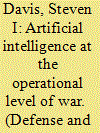

|
|
|
|
|
| Summary/Abstract |
Artificial intelligence (AI) is an emerging technology with widespread applications. The National Defense Strategy highlights the importance of AI to military operations for the United States to retain an advantage against its near-peer competitors. To fully realise this advantage, it will be necessary to integrate AI not only at the tactical level but also at the operational level of war. AI can be integrated into the complex task of operational planning most efficiently by subdividing it into its component operational functions, which can be processed by narrow AI. This organisation reduces problems to a size that can be parsed by an AI and maintains human oversight over machine supported decision-making.
|
|
|
|
|
|
|
|
|
|
|
|
|
|
|
|
| 2 |
ID:
184081
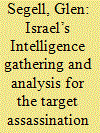

|
|
|
|
|
| Summary/Abstract |
On 12 November 2019 Baha Abu al-Ata, a leader of the Palestinian Islamic Jihad in Gaza was targeted assassinated by Israel. Intelligence was the driver of the operation – information and data were the components of intelligence gathering enabling informed decision-making via defence and security analysis. There was effective co-ordination and co-operation between the civilian government, the Israel Defense Force’s Units Skylark, Moran, 504, 8200 and 9900, and the Israel Security Agency. Policy and technicalities were integrated through civil–military relations. The methodology used six sets of different types of intelligence gathering, analysis and risk assessment that were separate yet simultaneously were asking: why, who, when, where, how (what weapon), and assessing repercussions.
|
|
|
|
|
|
|
|
|
|
|
|
|
|
|
|
| 3 |
ID:
184079
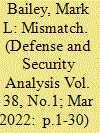

|
|
|
|
|
| Summary/Abstract |
Large-scale illegal fishing commenced in Australian coastal reefs 1970. Since, the Royal Australian Navy (RAN) has been “out of synch” with matching its Tier 2 constabulary vessels to their mission. The pattern is that “mission goalposts” shift post-acquisition, reflecting changes to UNCLOS. Post-WWII, the RAN employed wartime escorts in patrol roles, and wartime launches for littoral constabulary. The RAN has recreated this mix in the twentyfirst century. This paper traces this process and associated problems. Minimum resources are assigned to constabulary functions in peacetime, yet the units involved are arguably the most operational and politically sensitive. Vessel unsuitability has consistently meant personnel problems, over-use of constabulary vessels, and high maintenance costs. Australia's strategic situation is deteriorating towards a point where the rising risk demands mobilisation responses. This would include rapid acquisition of large numbers of Tier 2 assets to meet existing and conflict low-mix roles.
|
|
|
|
|
|
|
|
|
|
|
|
|
|
|
|
| 4 |
ID:
184080
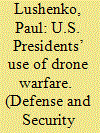

|
|
|
|
|
| Summary/Abstract |
Scholars often reduce America's use of drones to a bureaucratic process. While this enables them to recognise shifts in America's use of strikes since 2002, they cannot adequately explain such change over time. Rather, I argue that America's use of strikes is a function of presidents' decisions. Presidents adopt strategic and legal-normative cognitive frames that shape their decisions to use strikes. I use this typology to study crucial and pathway cases during the Obama and Trump administrations. I show that presidents' decisions to use drones are made to achieve state and social goals. The balance between these aims is informed by, and constitutive of, presidents' strategic and legal-normative frames. Understanding America's use of drones as a leader-driven practice suggests that the legitimacy of strikes may relate more to their impact on the relationship between norms and interests, and not the military or political nature of targets, as some ethicists claim.
|
|
|
|
|
|
|
|
|
|
|
|
|
|
|
|
| 5 |
ID:
184083
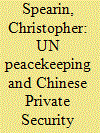

|
|
|
|
|
| Summary/Abstract |
Using China’s UN peacekeeping as a foil, the article explores the demand factors that inform the usage of Chinese Private Security Companies (PSCs) to protect Chinese economic interests and nationals abroad. The article makes three assertions. First, compared to Chinese peacekeepers, PSCs can offer a more focused and responsive presence overseas, a presence that is increasingly demanded by the Chinese leadership and citizenry. Second, Chinese PSCs can provide a less prominent footprint for when Chinese agendas and approaches, despite the desire to maintain a policy of non-interference, inevitably clash with local political dynamics and actors. Third, when considering Chinese peacekeepers that increasingly face the pressure to apply lethal violence, Chinese policy regarding the PSC employment of firearms constrains more robust PSC responses to security challenges that might further inflame sensitive matters regarding non-interference.
|
|
|
|
|
|
|
|
|
|
|
|
|
|
|
|
| 6 |
ID:
184084
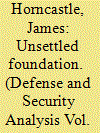

|
|
|
|
|
| Summary/Abstract |
Whilst scholars have examined the long-term political, social, and cultural dynamics with regards to Yugoslavia’s collapse, the military has largely escaped similar scrutiny. This paper explores the League of Communists of Yugoslavia’s attempt to solve the nationalist problems of Yugoslavia through the ideology of self-management, and how the failure to do so affected the strategy of Total National Defence. The republics were able to construct their own armed forces due to Total National Defence’s devolution of powers and self-management making changes to the policy extremely difficult for the federal government and Yugoslav People’s Army.
|
|
|
|
|
|
|
|
|
|
|
|
|
|
|
|
|
|
|
|
|